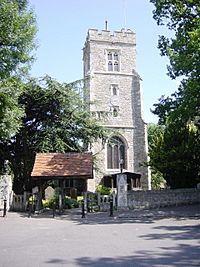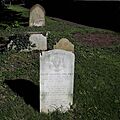St Leonard's Church, Heston facts for kids
Quick facts for kids St Leonard's Church Heston |
|
|---|---|

St Leonard's Church
|
|
| Location | Heston Road, Heston TW5 0RD, London |
| Country | England |
| Denomination | Church of England |
| History | |
| Status | Parish church |
| Architecture | |
| Functional status | Active |
| Administration | |
| Parish | St Leonard Heston |
| Deanery | Hounslow |
| Archdeaconry | Archdeaconry of Middlesex |
| Diocese | Diocese of London |
St Leonard's Church is a special old building in Heston, London. It's a Church of England parish church, which means it serves the local community. This church is also a "Grade II* listed building." This means it's a very important historic building that needs to be protected.
History of St Leonard's Church
St Leonard's Church has a long history, going back to the 1300s. But people were worshipping in Heston even earlier, with records of a priest from the 600s!
In 1086, after William the Conqueror took over England, the land where Heston is located was given to a person named Walter of Saint-Valéry. Later, the church was given to a monastery called the Abbey of Saint-Valéry.
Around 1270, Heston became its own separate church area, or parish. This happened under Richard, 1st Earl of Cornwall, who was in charge of the area. Richard was the second son of John, King of England. He had been on a special journey called the Barons' Crusade in 1239. During this journey, he helped get prisoners released. Because Saint Leonard is known as the patron saint of prisoners, it's possible that Richard dedicated the church to him. We don't know the exact date this happened.
The church tower is very old and survived when other parts of the church were rebuilt in the 1800s. The old gate to the churchyard, called a lychgate, also survived.
The churchyard is a burial ground. It holds the grave of Private Frederick John White. He died in 1846 after a harsh punishment at Hounslow Barracks. People were very upset about his death. This led to changes in how punishments were given, and eventually, this type of punishment was stopped completely. The famous scientist and explorer Sir Joseph Banks (1743–1820) and his wife are also buried here.
Church Design and Features
The church tower is built in a style called "Perpendicular Gothic," which was popular in the late Middle Ages. A famous expert named Nikolaus Pevsner said it was one of the best towers of its kind in the area. It looks similar to the tower of All Saints' Church, Isleworth.
The tower has special features like a small turret on the south-east side and strong supports called buttresses. It has windows with three sections on the west side and tall windows with two sections in the bell tower area. The top of the tower has decorative walls with battlements and carved gargoyles. The entrance porch on the west side has a special arch and carved decorations. The main part of the church was rebuilt in the 1800s to look like it was from around 1300.
Inside the Church
The arch leading to the tower is tall and decorated, typical of churches from the 1400s. Inside the church, between the main area (the nave) and the side sections (the aisles), the pillars holding up the arches are sometimes round and sometimes octagonal. This was a common design in medieval churches. The arches in the outer north aisle are said to use parts from the older church.
The arch leading to the main altar area (the chancel) is also decorated. The roofs of the nave, chancel, and outer north aisle have a special design with curved wooden supports. The tower and the nave are separated by a modern glass wall.
Most of the wooden benches (called pews) from the 1800s are still there. Some were moved to make space for the altar, which was brought forward. Many old memorials from the original church also remain. One important memorial in the Lady Chapel is for Robert Child and his family, who owned Osterley Park. This memorial was designed by a famous architect named Robert Adam.
The church also has a beautiful collection of stained glass windows. Some of these were made by well-known artists like C E Kempe and the company Heaton, Butler and Bayne.
Gallery
-
The grave of Private Frederick John White.








